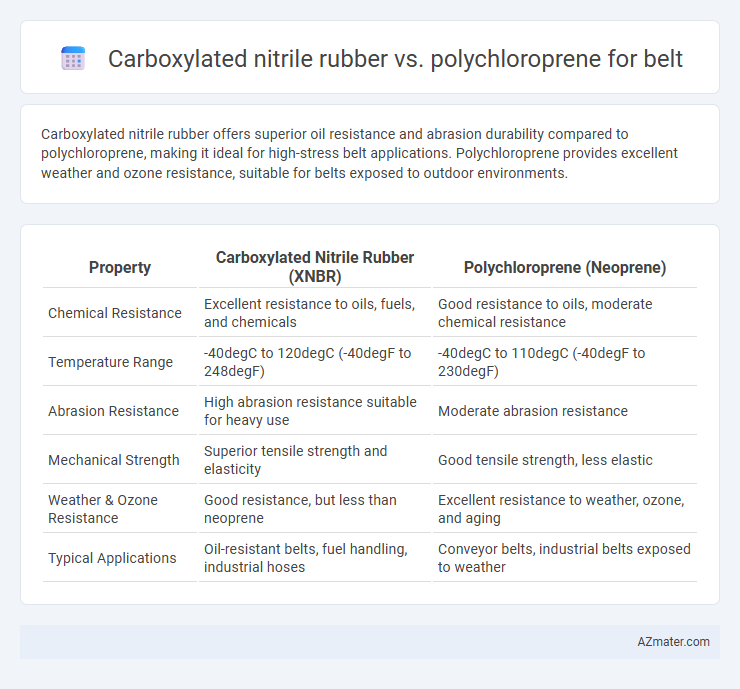Carboxylated nitrile rubber offers superior oil resistance and abrasion durability compared to polychloroprene, making it ideal for high-stress belt applications. Polychloroprene provides excellent weather and ozone resistance, suitable for belts exposed to outdoor environments.
Table of Comparison
| Property | Carboxylated Nitrile Rubber (XNBR) | Polychloroprene (Neoprene) |
|---|---|---|
| Chemical Resistance | Excellent resistance to oils, fuels, and chemicals | Good resistance to oils, moderate chemical resistance |
| Temperature Range | -40degC to 120degC (-40degF to 248degF) | -40degC to 110degC (-40degF to 230degF) |
| Abrasion Resistance | High abrasion resistance suitable for heavy use | Moderate abrasion resistance |
| Mechanical Strength | Superior tensile strength and elasticity | Good tensile strength, less elastic |
| Weather & Ozone Resistance | Good resistance, but less than neoprene | Excellent resistance to weather, ozone, and aging |
| Typical Applications | Oil-resistant belts, fuel handling, industrial hoses | Conveyor belts, industrial belts exposed to weather |
Overview of Carboxylated Nitrile Rubber and Polychloroprene
Carboxylated nitrile rubber (XNBR) exhibits enhanced tensile strength, abrasion resistance, and oil resistance compared to standard nitrile rubber, making it ideal for high-performance belts in industrial applications. Polychloroprene (Neoprene) offers excellent weathering, ozone, and chemical resistance, combined with moderate oil resistance and good mechanical properties, suitable for diverse belt environments. The selection between XNBR and polychloroprene depends on factors such as operating temperature, exposure to oils or chemicals, and required durability in belt applications.
Material Composition and Structure
Carboxylated nitrile rubber (XNBR) contains nitrile groups with carboxylic acid functionalities, providing enhanced adhesion, abrasion resistance, and chemical stability due to its polar molecular structure. Polychloroprene (neoprene) consists of chlorinated polyisoprene chains, offering balanced elasticity, weather resistance, and moderate chemical resistance with a slightly cross-linked network. The carboxylic groups in XNBR create stronger intermolecular bonds than polychloroprene's chlorine atoms, resulting in superior tensile strength and durability for belt applications exposed to oils and mechanical stress.
Mechanical Strength Comparison
Carboxylated nitrile rubber (XNBR) offers superior tensile strength and abrasion resistance compared to polychloroprene (neoprene), making it ideal for heavy-duty belt applications requiring high mechanical durability. XNBR exhibits enhanced elasticity and tear resistance, which prolongs belt lifespan under dynamic stress. Polychloroprene provides moderate mechanical strength but excels in chemical and weather resistance, making it suitable for belts exposed to harsh environments where mechanical stress is less critical.
Abrasion and Wear Resistance
Carboxylated nitrile rubber (XNBR) exhibits superior abrasion and wear resistance compared to polychloroprene, making it ideal for high-performance belt applications requiring prolonged durability under frictional stress. XNBR's enhanced crosslinking density and polarity improve its mechanical strength and resistance to oil and chemicals, resulting in less material degradation over time. Polychloroprene offers moderate abrasion resistance but typically underperforms relative to XNBR in harsh environments, limiting its effectiveness in heavy-duty conveyor or transmission belts.
Chemical and Oil Resistance
Carboxylated nitrile rubber (XNBR) exhibits superior chemical and oil resistance compared to polychloroprene, making it highly effective in environments with strong petroleum-based solutions and fuels. XNBR's enhanced polar carboxyl groups improve its resistance to hydrocarbon oils, acids, and alkalis, providing longer service life in harsh chemical settings. Polychloroprene offers moderate chemical resistance but falls short in prolonged exposure to aggressive oils and solvents, limiting its use in heavy-duty oil applications.
Temperature Range Performance
Carboxylated nitrile rubber (XNBR) offers superior temperature range performance from -40degC to 120degC, maintaining excellent abrasion resistance and oil compatibility for belt applications. Polychloroprene (CR) performs well within a narrower temperature window of -30degC to 100degC, providing good weather and ozone resistance but less thermal stability compared to XNBR. For belts exposed to wider temperature fluctuations and aggressive environments, Carboxylated nitrile rubber ensures improved durability and operational reliability.
Flexibility and Elasticity
Carboxylated nitrile rubber (XNBR) offers superior elasticity and flexibility compared to polychloroprene (neoprene), making it ideal for belts requiring high elongation and recovery properties. XNBR's enhanced polar groups improve tensile strength and abrasion resistance, while maintaining flexibility in low temperatures that polychloroprene may stiffen under. Polychloroprene provides good overall flexibility but lacks the exceptional elastic resilience and chemical resistance found in carboxylated nitrile rubber belts.
Cost and Availability Analysis
Carboxylated nitrile rubber (XNBR) typically offers lower material costs compared to polychloroprene (neoprene), making it a more budget-friendly option for belt applications. XNBR's widespread production and robust supply chain enhance its availability worldwide, whereas polychloroprene, while durable, often faces higher price points due to more complex manufacturing processes and fluctuating raw material costs. Availability of XNBR belts is generally better in markets demanding oil and chemical resistance, whereas polychloroprene belts serve niche markets requiring superior weathering and ozone resistance but at a higher cost.
Typical Applications in Belt Manufacturing
Carboxylated nitrile rubber (XNBR) is preferred in belt manufacturing for applications requiring excellent oil resistance, abrasion durability, and mechanical strength, making it suitable for conveyor belts in automotive and industrial settings. Polychloroprene (Neoprene) is favored for belts exposed to weathering, ozone, and moderate chemical exposure, commonly used in marine, agricultural, and general-purpose conveyor belts. Both materials provide robust performance, but XNBR excels in high-wear, oily environments while polychloroprene offers superior environmental resistance in outdoor or harsh chemical settings.
Choosing the Right Material for Belt Solutions
Carboxylated nitrile rubber (XNBR) offers superior abrasion resistance, tensile strength, and chemical resilience, making it ideal for heavy-duty belt applications exposed to oils and fuels. Polychloroprene (neoprene) provides excellent weather, ozone, and chemical stability, suitable for belts used in outdoor or harsh environmental conditions. Selecting the right belt material depends on operational demands, with XNBR favored for mechanical stress and oil resistance, while polychloroprene excels in environmental durability and flexibility.

Infographic: Carboxylated nitrile rubber vs Polychloroprene for Belt
 azmater.com
azmater.com